Note: This guide also applies to Dirac Live 3. Last update 17.03.2021
Setting crossovers in an AVR/pre-pro with Dirac Live 2 room correction
This tutorial shows how to set crossover frequencies in an AVR/pre-processor for subwoofer and satellite speakers based on data captured by Dirac Live 2 room correction.
Requirements
AVR with Dirac Live 2/3 room correction, Mac or PC capable of running Dirac Live 2.5 or later.
Basics
Bass management in AVRs provides crossovers that separate low and high frequencies. First the signal is split into two different channels. Then a high pass filter is applied to the channel that should carry only higher frequencies (signal going to a satellite speaker) and a low pass filter is applied to the channel that should carry only lower frequencies (signal going to the subwoofer). The crossover point is the frequency where the resulting two frequency response curves cross each other.
High and low pass filters found in common AVRs aren't brick wall filters, i.e. both the subwoofer and the satellite speaker contribute to the response around the crossover frequency. The overlapping frequency region where there is significant interaction typically extends from about 1 octave below the crossover point (half the frequency) to about 1 octave above (double the frequency). Here's a graph showing how the low frequency portion (red) and the high frequency portion (blue) ideally combine (green). The crossover frequency in this example is 100Hz.
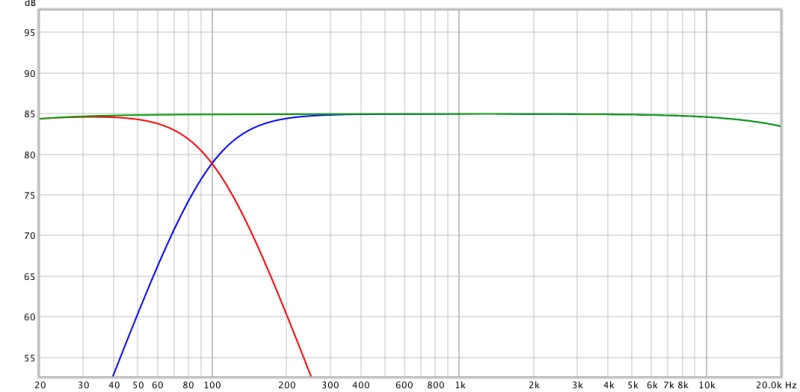
Determine potential crossover points
After measuring your speakers or opening a previously saved project go to the "Filter Design" tab. Examine the "Spectrum (Corrected)" curve for each satellite speaker (or group of satellites) and locate the frequency where the corrected response curve starts to fall off from the target curve at low frequencies. This is the low frequency cut-off point. The lowest usable crossover frequency is roughly 1 octave above. Then find the high frequency cut-off point for the sub. The highest usable crossover frequency is roughly 1 octave below.
Here's some exemplary data:
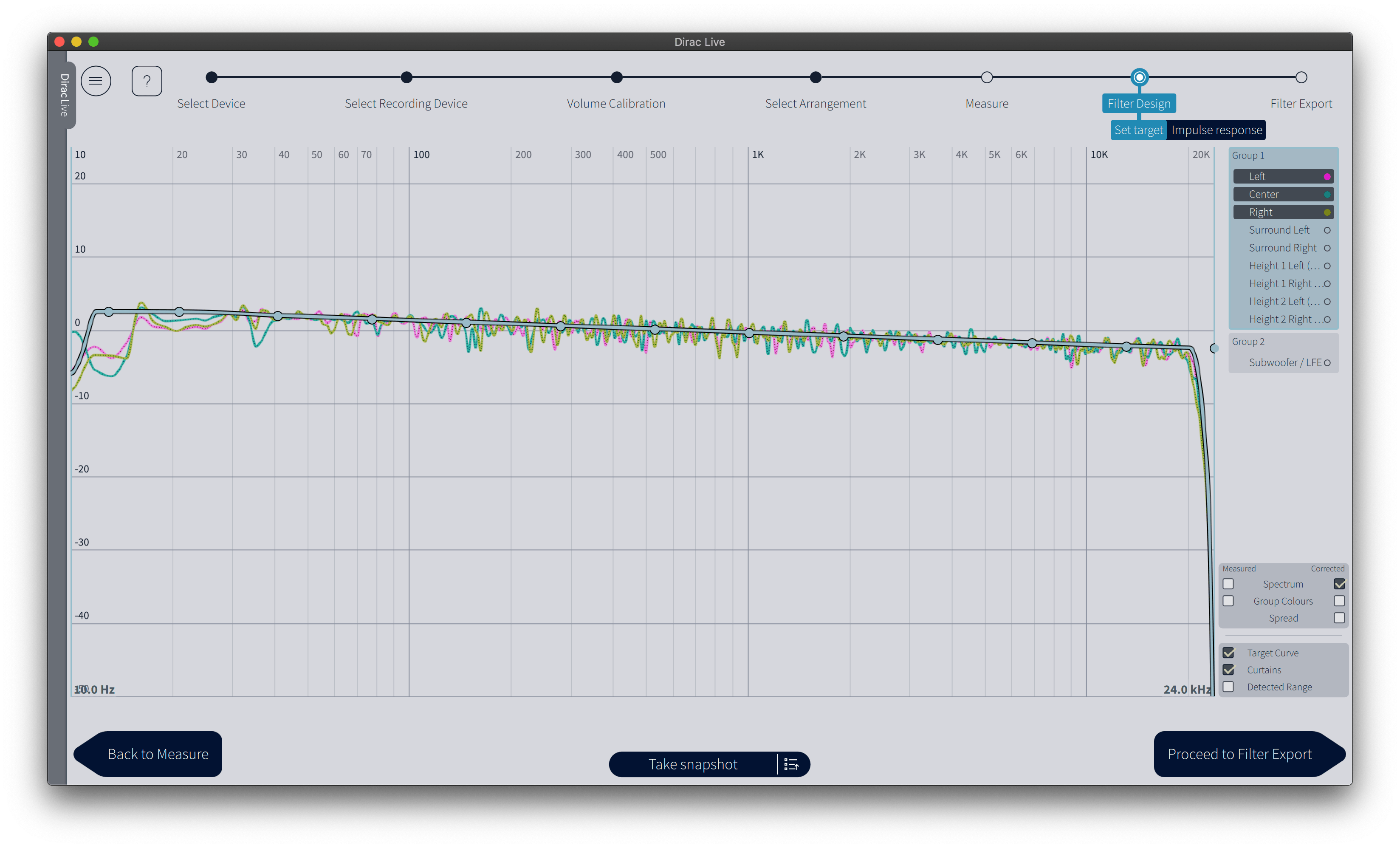
The lower cut-off point for the left, right and center speaker is at around 40Hz. This allows a crossover frequency of 80Hz (40Hz * 2 = 80Hz) or higher.
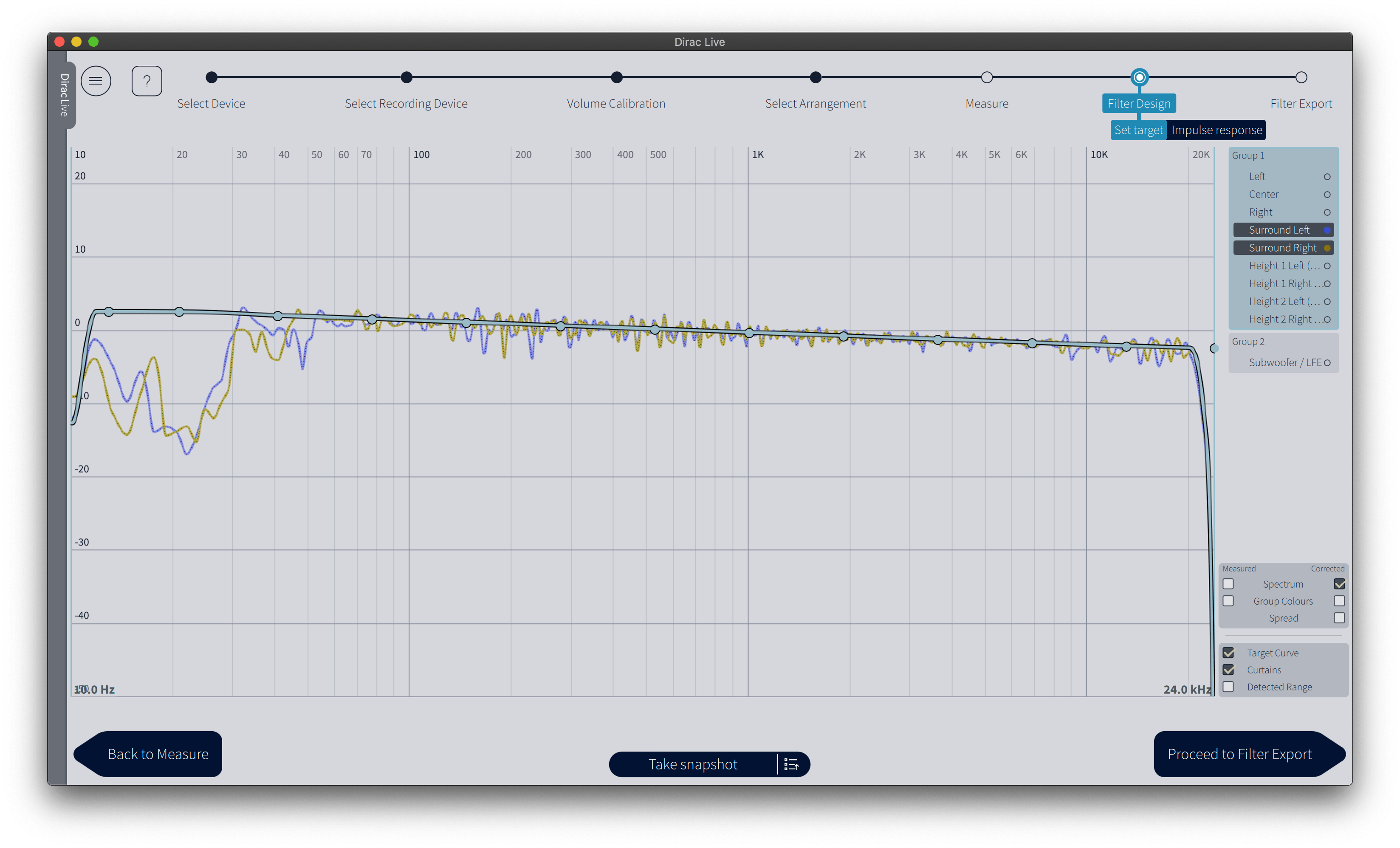
The lower cut-off point for the surround speakers is at around 53Hz. This allows a crossover frequency of 106Hz (53Hz * 2 = 106Hz) or higher.
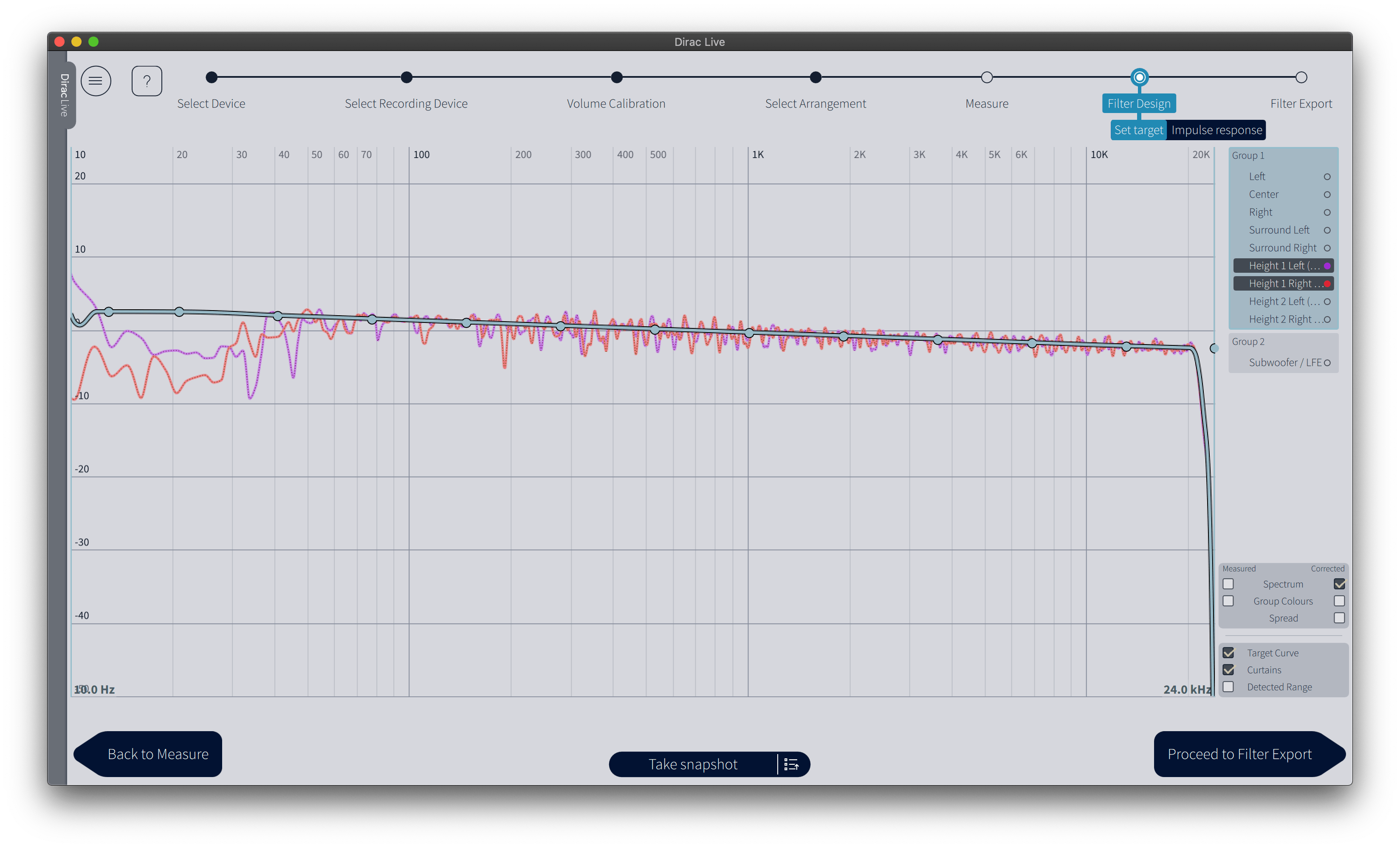
The lower cut-off point for the top surrounds is at around 48Hz. This allows a crossover frequency of 96Hz (48Hz * 2 = 96Hz) or higher.
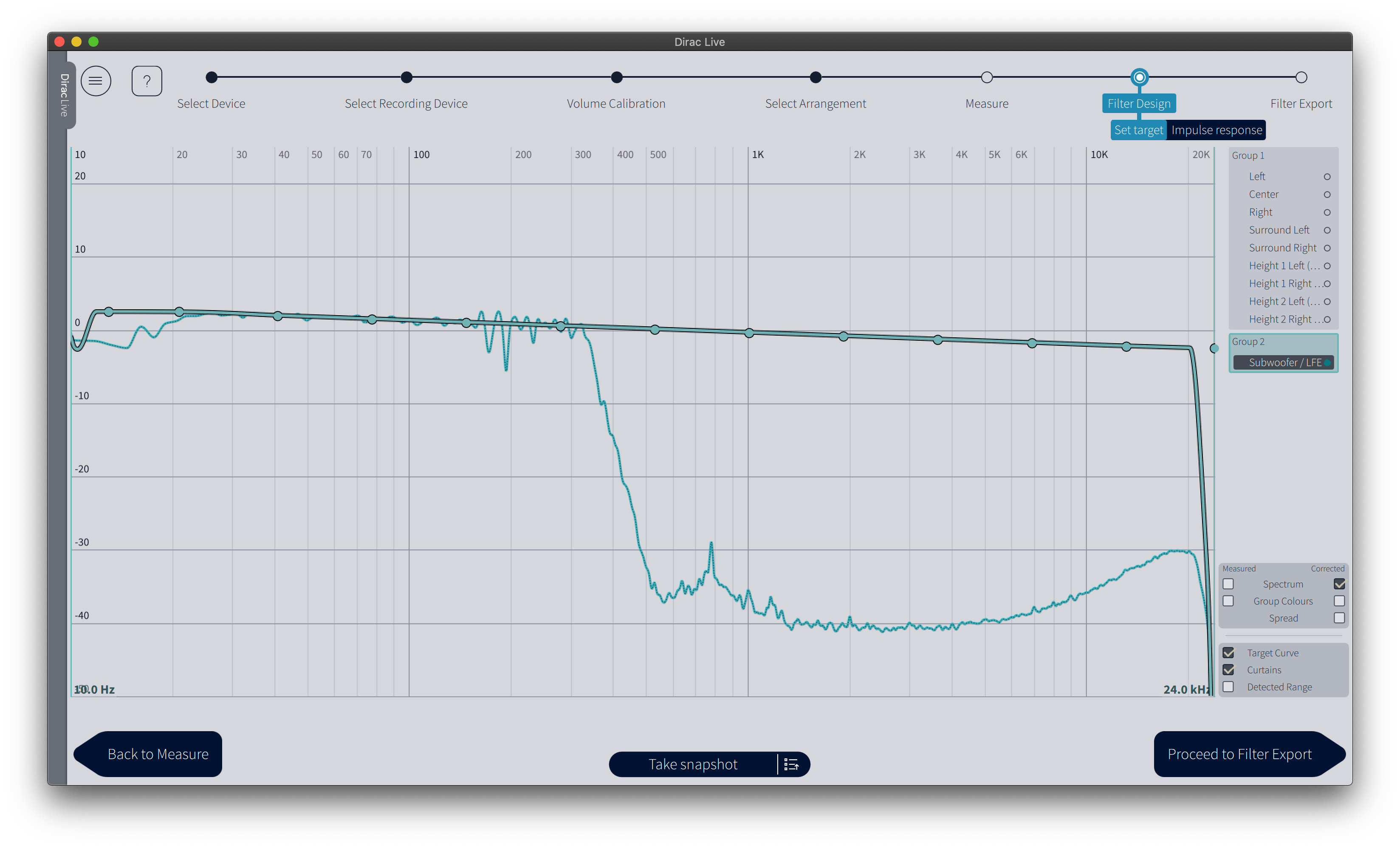
The upper cut-off point for the subwoofer extends beyond 300Hz. This allows a crossover frequency of 150Hz (300Hz / 2 = 150Hz) or lower.
Choosing appropriate crossover points
Generally speaking the satellite/subwoofer crossover frequency should be as high as possible in order to benefit from spatially optimized, monophonic bass. On the other hand the subwoofer(s) shouldn't become localizable which requires a crossover frequency of about 80Hz or lower. So ideally the target is a crossover point of 80Hz for all speakers.
Make sure you set the same crossover point for stereo pairs, i.e. left/right, left/right surrounds, etc. to avoid imaging issues. Most AVR's don't allow differing frequencies for stereo pairs anyway. It makes sense to use the same crossover point for all the front speakers (center, left and right) as different crossover points can lead to interference effects when redirected bass signals from speakers set to small are combined in the subwoofer channel.
If measurements show very high cut-off points for satellite speakers and therefore the crossover point would rise above 80Hz, you're risking your subwoofer(s) to become localizable. In such a case the first step is to change speaker and/or listening position. The early fall-off could be caused by room effects. Rerun Dirac Live and check whether the response improved or not. If the speaker itself isn't capable of going deeper then it's time to get a better speaker. If any of this isn't possible then one needs to experiment with different crossover settings for that speaker. Often a hole in the frequency response caused by an inappropriately low crossover point is perceptually better than selecting a high crossover and the sub becoming localizable. On the other hand the speakers have to work harder which can push them over their electrical or mechanical limit.
Loudspeakers with a port
Special care has to be taken when bass reflex satellites or subwoofers are used. Below the tuning frequency of the port (this is the frequency where the woofer shows the least amount of excursion) the driver largely acts as if it is suspended in free air. Although it doesn't create much usable output it shows high excursion and is easily pushed beyond its mechanical limit. The voice coil can hit the pole plate resulting in physical damage. There's also a second effect called "dynamic compression". The voice coil heats up, the driver parameters change and the driver starts to compress (doesn't get any louder). Worst case the voice coil assembly gets too hot, burns out and the driver needs to be replaced.
Both conditions are easily met when room correction filters are applied. Dirac Live can boost frequencies by as much as 10dB which is 10 times the power. The remedy for this is to know the speaker's port tuning frequency and apply a gentle fall-off via the target curve or use the left curtain to limit filter activity beyond the port tuning frequency (drag the left curtain to the right until the target curve "knee" roughly meets the "knee" of the corrected response fall-off). Tightly plugging the port will also make the speaker more robust at lower frequencies.
(Common) special cases
Unfortunately AVR manufacturers haven't been very innovative when it comes to improving sound quality in areas where it would really matter, namely bass management. There is no automated solution for optimizing the crossover region between sub(s) and satellites (only exception is JBL Synthesis' ARCOS or Audyssey's now defunct installer kit). Some AVRs don't even have the ability to apply different crossover frequencies to different speakers, e.g. Arcam AVR390/550/850/860, Lexicon MC-10/RV-9/RV-6. Don't waste your money on such inferior bass management implementations which prevent getting the best out of your amps, speakers and room.
A lot of AVRs come with bass management filters that don't sum to a flat response. For example 24dB/octave Butterworth filters create a peak of 3dB around the crossover frequency. Some AVRs present a mixture of 6dB, 12dB or 24dB filters which can produce disastrous results. Bass management filters that work with Dirac Live need to sum to a flat response, e.g. 24dB/octave Linkwitz-Riley filters (see example at the top).
Some (home theater) speakers are designed to fall off below about 80Hz. Such speakers won't work with Dirac Live or any kind of room correction system because the usable speaker response needs to extend about 1 octave below the intended crossover frequency as explained above.
Some subs have low pass filters that can't be switched off. Again such a sub might not work with Dirac Live because the usable frequency response needs to extend about 1 octave beyond the intended crossover frequency. If the sub's low pass filter is adjustable set it to the highest frequency available before running Dirac Live.